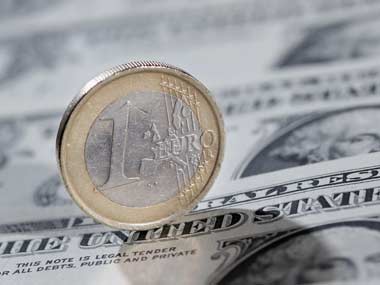Singapore: The euro surged on short covering on Monday after an Italian newspaper said the International Monetary Fund was preparing an aid package for Italy, but doubts about the feasibility of the reported plan kept the outlook uncertain.
The euro rose 0.6 per cent to $1.3331 after the unsourced report in Italian daily La Stampa said up to 600 billion euros could be made available at a rate of between 4-5 per cent to give Italy breathing space for 18 months.
[caption id=“attachment_141664” align=“alignleft” width=“380” caption=“Reuters”]  [/caption]
The report helped soothe market nerves as Italy plans to raise up to 8 billion euros in the bond market on Tuesday . But market players remained sceptical about the IMF aid as such a sum would be beyond its current capacity.
A source with knowledge of the matter told Reuters that contacts between the IMF and Rome had intensified but added it was unclear what form of support could be offered if a market selloff on Monday forced immediate action.
Official sources in Rome said they were unaware of any request for assistance from Italy.
While the IMF may potentially employ a stand-by or precautionary lending facility for Italy, aid amounting to 600 billion euros sounds far too large, said Ray Farris, head of foreign exchange strategy for Credit Suisse in Singapore.
“It would imply that the fund (IMF) would give all of its existing resources plus additional resources it would have to tap from its members for once country, and that seems highly imprudent,” he said.
There are some “potential positives” for the euro that have emerged in recent days including news last week that the European Central Bank is looking at extending the terms of loans it offers banks to 2 or even 3 years, but its outlook hinges on forthcoming policy decisions by euro zone members such as France and Germany as well as the European Central Bank, Farris said.
BENEFIT OF THE DOUBT
The euro climbed to as high as around $1.3345 at one point, with initial resistance seen around $1.3354, the 5-day moving average. Higher up, it faces resistance near $1.3414, the conversion line on the daily Ichimoku chart, a popular technical analysis tool.
It has fallen some 7 per cent – from a high of $1.4248 on Oct. 27 to a trough near $1.3213 on Nov. 25 – as the debt crisis spread through Europe.
Selling pressure on the euro strengthened last week in the wake of a weak bond auction in Germany, the euro zone’s safest haven. Italy’s short-term debt sale on Friday was also poorly received, sending Italian two-year yields to a euro-era high above 8 per cent on Friday.
“Unless we see a confirmation the IMF is working on such a programme, I suspect the market is going to want to sell into any further strength,” said Robert Rennie, chief currency strategist at Westpac Bank in Sydney, regarding the La Stampa report.
“But I would certainly be willing to give this the benefit of the doubt at least through the Asian session.”
The bounce in the euro saw the dollar index fall 0.7 per cent to 79.109, retreating from a two-month peak of 79.702 set Friday. Against the yen, the dollar dipped 0.2 per cent to 77.62.
Commodity currencies followed the euro higher, with the Australian dollar jumping 1.7 per cent to $0.9884.
Euro zone finance ministers will meet on Tuesday where detailed operational rules for the euro zone’s bailout fund are ready for approval, documents obtained by Reuters showed.
The approval of the rules will clear the way for the 440 billion euro facility to attract cash from private and public investors to its co-investment funds in coming weeks, which, depending on interest, could multiply the EFSF’s resources.
Reuters


)
)
)
)
)
)
)
)
)



